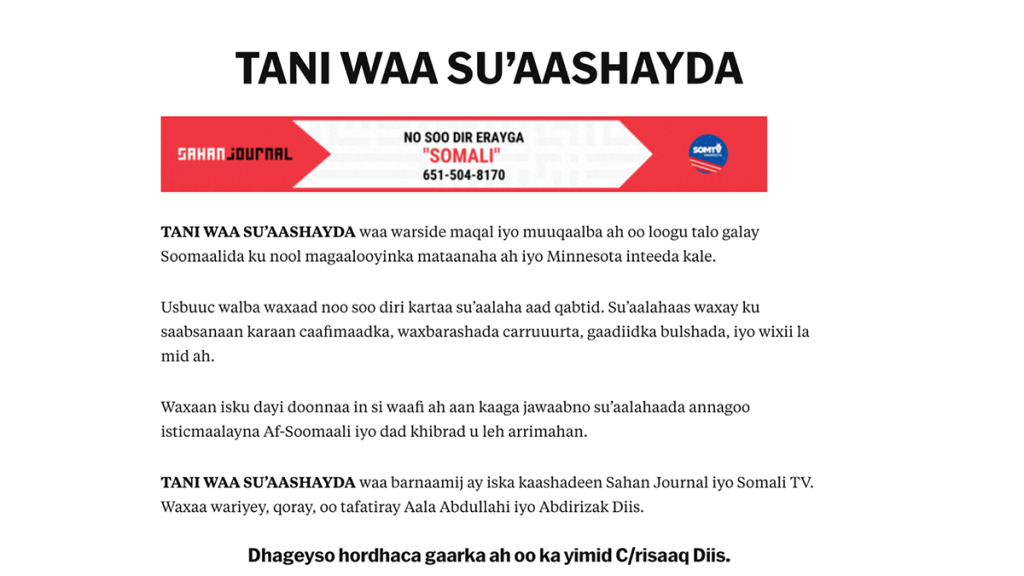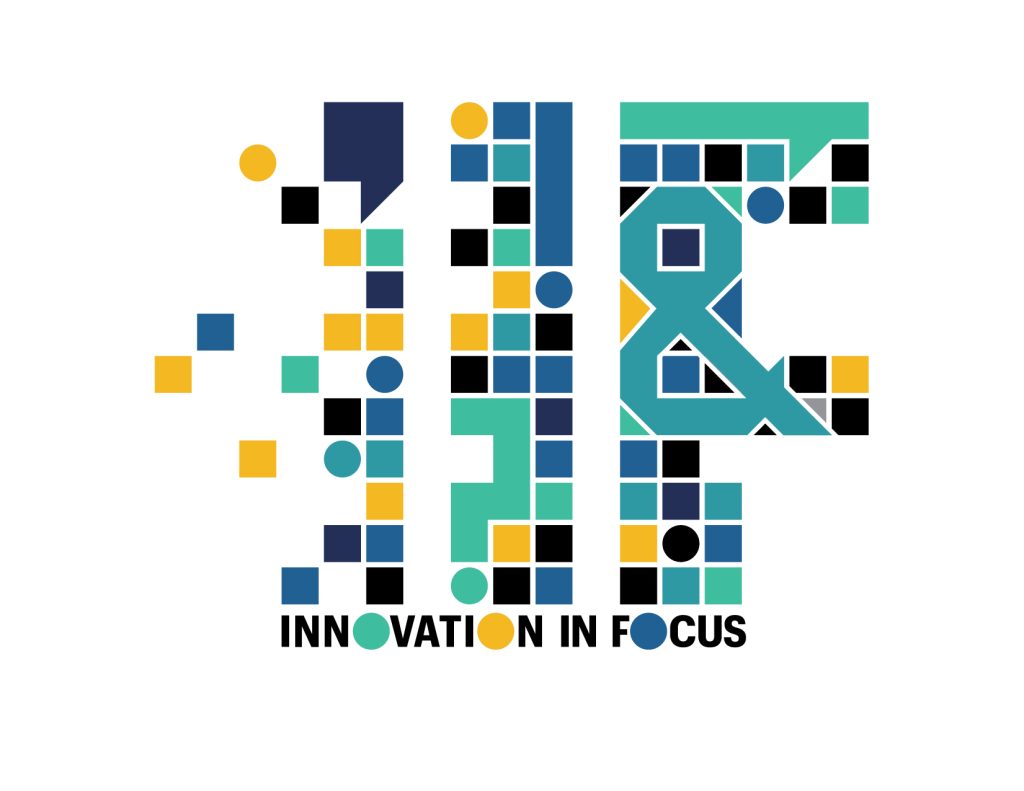
Reaching multilingual communities starts with listening and collaboration
A conversation with Aala Abdullahi
Aala Abdullahi is the innovation editor at Sahan Journal in Minnesota, where she has focused on merging community engagement with product development. Some of the tools and projects she has produced include a weekly audio newsletter and text-message service for the local Somali community, as well as an SMS newsletter service in Pashto and Dari for Afghans new to Minnesota.
The Innovation in Focus team spoke with Abdullahi to learn about her experience engaging multilingual communities and any guidance she could offer for community news organizations looking to translate news stories into different languages.

Aala Abdullahi is the innovation editor at Sahan Journal in Minnesota.
Lytle: What are your past strategies to engage underserved communities who are from a different cultural background?
Abdullahi: The first piece of advice is to never assume that you know exactly what these communities need. Your first step should always be direct face-to-face community engagement work — whatever that looks like.
In our case, it was a series of community listening sessions where we specifically targeted different age groups in the three largest immigrant communities in the state of Minnesota. It was the Somali community, the Latino community, and the Hmong community. We had four weeks of listening sessions for each community, and we asked very targeted questions around how they felt about media organizations, whether they’ve even had any kind of formal relationship, what they felt like was missing from their narrative, how they use news in their daily lives, and if they didn’t, why not?
From there, what we learned — and this is something we kind of already knew but was good to hear said back to us — was that people need news in their language. And not only do they need news in their language, but they also need it in audio or visual formats. For example, this was very important to oral cultures and communities like the Somali community and the Hmong community.
Then, once we [gathered] all of our learnings, we said, ‘let’s test it out on at least one news product,’ and the way that took shape is we decided to do a newsletter in Somali. But we wanted to make sure that we captured the fact that our news readers wanted us to have that in audio format. And we also always wanted to test out how SMS services could help us get to the reader directly.
Lytle: Can you share a little more about what you learned and any challenges you faced while creating that Somali newsletter?
Abdullahi: Immediately, I ran into a few issues. I realized that there were file size limits, which meant that we could only send out audio files that were about 500 KB, which translates to about a maximum of 3 minutes and 30 seconds. Usually our stories on Sahan Journal would be about 5 minutes. So that would add an extra step in terms of editing if we really wanted to take a Sahan Journal story and turn it into a Somali audio file.
The next thing was in terms of analytics. For GroundSource, and I believe most of the other SMS services, one thing that they don’t offer you is open rate because you’re dealing with text message rate. So, really the only way that we’ve kind of been able to tell whether or not people are liking our content is if they’ve stayed subscribed.
Another limitation that we ran into was that there’s a lag time when you send out an audio file, and that strictly has to do with your telephone service provider. So if I’m with T-Mobile and you’re with AT&T, I can’t control when you get that audio file. I can get it 2 seconds after we send it out and then our producer could get it like 20 minutes later. Usually it’s within the hour, but if we’re sending out a series of text messages, I would have to stagger it and say, “OK, I’m gonna send out one this morning, another one 2 hours from now, another one 3 hours from now, just to make sure that people are getting them in the order that we need them to.”
The last thing is we found that anyone who was consuming news consistently in their language tended to be people who were relatively new to the country or were just a lot older and were part of more insular communities where they’re only dealing with other elders who speak Somali or speak Hmong around them. A lot of these people are not on social media like that or using their phones, unless it’s to send a text message or through WhatsApp. So it wasn’t enough for us to broadcast or promote the service online.
We ended up hiring a few community ambassadors who knew the community spaces where people who would be interested in a service like this would be, and we gave them a paper that has a QR code. They would go out and pitch this product to people. We also had people show up to committee meetings and have a signup sheet and we’d have someone stand at the beginning of the meeting and say, “hey, we’re running this service. It’s for people who are looking for news in XYZ language,” and then we would input that contact information ourselves.
Lytle: What do you think about when you consider next steps for these products?
Abdullahi: I think we’re still in that stage of distribution or promotion, but one thing we’re actively thinking about is how we can do local partnerships or events and workshops that people who are directly subscribed to this new newsletter can tap into or be a part of, so that they can meet other people who are part of this local community. I think we’re just about to hit 1,000 subscribers. But these are subscribers who are actively engaged, and I feel like it’d be really great to actually meet a lot of these people in person so they can get to know who’s behind the product.
Lytle: How do you decide which media platform or which kind of content is most effective to be delivered in print, audio or video format?
Abdullahi: We’re approaching all of this as an experiment. The whole point is to be able to test out, and as you develop a relationship with the community, you establish some kind of feedback loop where you’re able to understand: My product is doing well in this, not so well in this. How do we do more of what we’re doing well in? And then we iterate based off of that to a point where that product is (built) for a very specific community. Even if it’s a subset, it’s serving a certain community.
Lytle: Have you ever used machine translation with any specific tools, or do you only use human translation?
Abdullahi: It’s just straight up human translation. Usually the stories that we feature in our newsletters are either from Sahan Journal or our partner newsrooms like MPR or Star Tribune, and it’s about four to five stories a week. I act as the assignment editor, so I pick the stories that we feature every week and then I summarize those stories — but still in English. Sometimes I write the title or the headline or the question that we’re sending out in Somali. But for the most part, I take the summarized versions and send them directly to Abdirizak [Diis], who’s our Somali TV producer, [to translate]. He writes that script and then records it. I listen to it, and I edit that audio file down. Then, I send it to him to make sure that everything sounds good, and then we load that into GroundSource, and then we send it out.
Lytle: Do you have any tips for other news organizations trying to figure out how to build relationships and partnerships with community organizations?
Abdullahi: I think the first thing that always helps is knowing what your own goals are; as a newsroom, what you’re trying to accomplish with each product or if it’s an overall question that you’re trying to answer, and what it will take for you to actually get those answers. Then from there, look at who’s doing that really well or people who are at the same stage as you. So either you’re going to be able to learn from your partnerships because they’re 10 steps ahead of you, or you’re going to be learning together.
For the partnerships that we established with Somali TV, La Raza and Hmong TV, they had already put in years and years of work establishing trust with the local communities that they served. So they had a lot of brand recognition, whereas I felt like we were a newer news organization, especially when it comes to serving the non-English language audiences. But one thing that we had was that we had a lot more reporting capacity than they did. So we knew that partnership had to come from a place of “we’re going to go into this knowing we want to be able to produce non-English language journalism more sustainably,” and we wanted to be able to partner with news organizations that will help us do that.
Also, this was a huge project. It took about a year, year and a half. So, we wanted to make sure that the first time that we worked with these news organizations wasn’t on this big project.
For two years before we did this project, we were already partnering with these community organizations but on smaller projects. For example, we did an election video series with each of these newsrooms where we did a community engagement listening session figuring out what the Latino, the Somali and the Hmong communities each wanted to know about the election. We turned that into a segment that aired on all three platforms. That gave us a really good understanding of what strengths we bring to the table, what strengths they bring to the table, and that way there’s no kind of confusion once we actually start working together in the long term.
Lytle: How would you advise a small newsroom who wants to improve their multilingual coverage but they lack the staff capacity to do human translation?
Abdullahi: Being bilingual and being able to produce news in multiple languages is a real skill. So if you were to do that as a newsroom, I would say that is something that has to be in the job description and has to be very intentional. You have to have hired that person specifically to do that work, and not only does the pay have to reflect that, but also the expectations. I think the most important thing is to figure out whether or not that’s something that your newsroom can do.
Can you hire for that? Do you have the capacity for that? Do you want to take the time to go out and find these reporters and editors who speak these languages and have that experience to do this journalism really well?
We’d already worked with Somali TV, Hmong TV and La Raza, and had access to newsrooms that have those reporters and writers and editors. I would say build that relationship; that might take some time but test it out. Maybe you hire a reporter as a freelancer from that newsroom to help you do a specific story and collaborate. Then from there, you build that long term relationship. That was an intentional step on our part to know that this wasn’t something that we had capacity for in our newsroom, and we’d have to hire out for it in order for it to be done well. That also impacts the longevity and the sustainability of a program or a project that involves multilingual journalism. If you want to say this is something we’re going to try out for a year because we only have funding for a year, that’s also fine, but just make sure that is clear from the very beginning.
Lytle: Anything else that you wanted to share about your experiences serving multilingual audiences?
Abdullahi: This will always be an experiment. I say “experiment” as something you try out and from there you fine tune it until it becomes that thing that you absolutely adore, that you’re proud of. And sometimes those experiments fail. I think if we weren’t willing to just try something, put it out there and then hear directly from community members about whether or not it was serving their interests, I don’t think we would’ve been able to get as far or even have the learnings that we do now. Embracing that failure mindset is also very important when you’re trying something new.
Editor’s Note: This interview has been edited for clarity and brevity.

Sign up for the Innovation in Focus Newsletter to get our articles, tips, guides and more in your inbox each month!


Comments